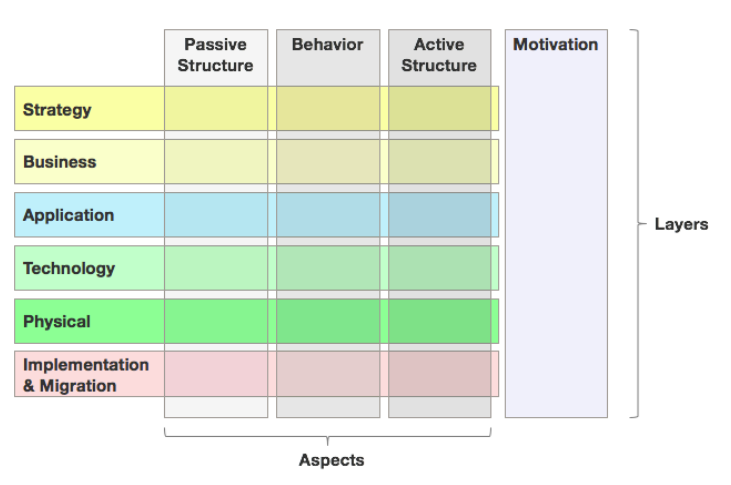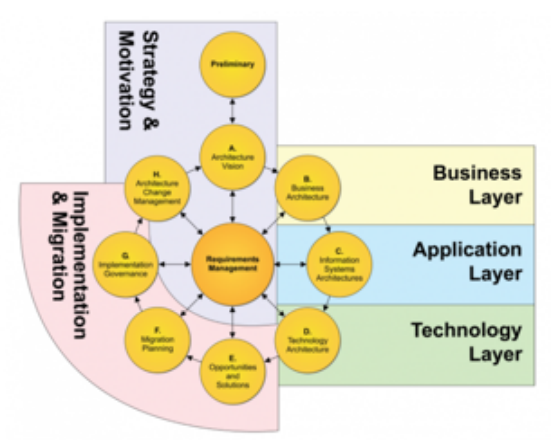Introduction
In the ever-evolving landscape of enterprise architectures, effective communication is paramount. The ArchiMate® standard emerges as the international graphical language dedicated to modeling these intricate structures. Serving as a powerful visualization tool, ArchiMate® provides a unified and comprehensive method for describing, analyzing, and visualizing architectures, differentiating itself from other modeling languages like UML or BPMN by adopting a more conceptual and less detail-oriented approach.
Key Features of ArchiMate®:
- Conceptual Focus: ArchiMate® offers insights into the structure and coherence of business processes, organizational structures, information flows, and technical infrastructure without getting bogged down in minutiae.
- Communication Enhancement: As IT landscapes grow in complexity, ArchiMate® facilitates a shared understanding of how IT is organized, promoting effective communication through a standardized visualization language.
- International Standardization: ArchiMate® is not just a language; it’s a standardized language. Its universality ensures that anyone familiar with and employing the language can interpret and utilize it, turning visualization into a standardized modeling practice.
- Comprehensive Modeling: ArchiMate® extends its modeling capabilities to both the business side (encompassing processes, services, and personnel) and the technological side (encompassing applications and infrastructure). The latest version even accommodates the modeling of production companies and logistics flows.
- Dynamic Behavior Visualization: Beyond static structures, ArchiMate® excels in portraying dynamic behaviors. Whether it’s illustrating how information flows through a process or how a process stores information in applications, ArchiMate® enables the visualization of a wide range of dynamic behaviors.
Strengths of ArchiMate® Standard:
- Guidance and Direction: ArchiMate® serves as a guiding force in architectural design, providing direction and coherence.
- Transformation Support: It aids in architectural transformations, motivating the need for change and facilitating substantive changes.
- Cohesion and Information Flow: ArchiMate® focuses on cohesion, information flow, and dynamic behavior within an architecture.
Advantages of Implementing ArchiMate® in Your Organization:
- Strategic Alignment: ArchiMate® bridges the gap between business strategy and IT implementation, ensuring alignment for effective execution.
- Clear Approach: It provides a clear and standardized approach to architecture, promoting consistency in identification and understanding.
- Governance: ArchiMate® instills governance, creating a structured framework for managing architectures.
- Efficiency and Cost Reduction: Through smarter projects, ArchiMate® contributes to the generation of sales and cost reduction.
- Transparency for Stakeholders: It offers transparency to business stakeholders, enabling a deeper understanding of architectural complexities.
- Budget Alignment: ArchiMate® ensures alignment between IT budget and business strategy and objectives.
- Smart Reuse: Encouraging the smart reuse of existing processes, applications, and infrastructure, ArchiMate® promotes efficiency in resource utilization.
- Sustainable Business Agility: ArchiMate® supports sustainable business agility, adapting to changes while maintaining operational effectiveness.
- Pragmatic IT Project Approach: Facilitating a pragmatic approach for IT projects, ArchiMate® enhances project planning and execution.
In essence, ArchiMate® emerges as a versatile and indispensable tool, not just for visualizing architectures but for driving informed decision-making, fostering collaboration, and navigating the complexities of modern enterprise landscapes.
The layers of the ArchiMate® standard:
The ArchiMate® standard comprises several layers, each playing a distinct role in modeling and understanding enterprise architectures. These layers provide a structured approach to capture and communicate different aspects of an organization’s structure and behavior. Here are the key layers of the ArchiMate® standard:
- Business Layer:
- Focuses on business concepts and structures.
- Describes business services, processes, actors, and roles.
- Emphasizes the customer-facing aspects of the organization.
- Application Layer:
- Deals with the application landscape that supports business functions.
- Describes application services, components, and their interactions.
- Provides insights into the software architecture of the organization.
- Technology Layer:
- Addresses the technology infrastructure necessary for applications.
- Describes technological services, hardware, and system software.
- Encompasses processing, storage, and communication services.
- Motivation Layer:
- Focuses on the drivers, goals, and principles guiding the organization.
- Describes stakeholders, their concerns, and the assessment of strategic goals.
- Provides a high-level view of why certain architectural decisions are made.
- Strategy Layer:
- Covers the approach and resources needed to bring about change.
- Describes the engagement strategy and the required human and material resources.
- Offers a roadmap for executing the strategic vision.
- Physical Layer:
- Extends the Technology layer by introducing physical elements.
- Models tangible entities such as equipment, materials, and distribution networks.
- Provides a bridge between the digital and physical aspects of the organization.
- Implementation & Migration Layer:
- Focuses on the temporal dimension of enterprise architecture.
- Enables modeling of project and portfolio management.
- Includes features for gap analysis, transition, and migration planning.
Each layer in the ArchiMate® standard contributes to a holistic understanding of the enterprise, allowing architects and stakeholders to articulate and visualize various facets of the organization’s architecture. The layers are interconnected, reflecting the interdependencies and relationships that exist within a complex business environment.

The components of the ArchiMate® standard:
- Motivation:
- Stakeholders: Individuals or groups with interests and concerns in the enterprise.
- Drivers for Change: External or internal factors motivating changes in the organization.
- Business Objectives: High-level goals that guide the organization.
- Principles: Fundamental guidelines influencing decision-making.
- Requirements: Specifications detailing what the system or solution must achieve.
- Behavior:
- Processes: Sequences of activities or tasks that lead to a specific outcome.
- Functions: Units of activity with a specific purpose within the organization.
- Events: Points in time or conditions that trigger processes or behaviors.
- Services: Actions or functions offered by components to achieve specific outcomes.
- Active Structure:
- Company Actors: Entities within the organization that exhibit behavior and perform roles.
- Application Components: Elements in the application layer that actively contribute to functionality.
- Devices: Physical entities such as computers, servers, or other hardware with active roles.
- Passive Structure:
- Information Objects (Business Layer): Represent data or information in the business context.
- Data Objects (Application Layer): Represent data entities in the application layer.
- Physical Objects: Represent tangible entities in the physical layer.
These components collectively form the building blocks of the ArchiMate® standard, enabling a comprehensive and structured representation of enterprise architecture. The standard’s versatility lies in its ability to articulate not only the static elements but also the dynamic aspects and the motivations driving organizational change.
TOGAF and ArchiMate
The ArchiMate® standard and the TOGAF® framework are powerful tools often used in tandem to enhance the effectiveness of enterprise architecture practices. Here’s a breakdown of how they intersect:

Integration of ArchiMate® Standard with TOGAF® Framework:
- Business, Application, and Technology Layers:
- These layers in the ArchiMate® standard align with the business, information systems, and technology architecture domains outlined by the TOGAF® framework.
- They provide a structured approach for describing and visualizing these domains, offering a clear understanding of their interrelationships.
- Strategy and Motivation Elements:
- Within the ArchiMate® standard, strategy and motivation elements come into play to support specific phases of the TOGAF® Architecture Development Method (ADM).
- They contribute to the Requirements Management, Preliminary, and Architecture Vision phases, helping define business objectives, architecture principles, and high-level business requirements.
- These elements are also relevant during the Architecture Change Management phase, as they aid in addressing changing requirements.
- Implementation & Migration Elements:
- The Implementation & Migration layer of ArchiMate® directly aligns with key phases in the TOGAF® ADM focused on implementing and migrating architectures.
- It plays a crucial role in the Opportunities and Solutions, Migration Planning, and Implementation Governance phases of TOGAF®.
- These elements guide the practical aspects of transforming architecture into actionable plans and ensuring effective governance during implementation.
Overall Integration:
The combined use of ArchiMate® and TOGAF® provides a comprehensive approach to enterprise architecture. ArchiMate® offers a visual language for modeling and analyzing architectures, while TOGAF® provides a systematic framework for developing and managing enterprise architectures.
This integration ensures a seamless flow between the strategic envisioning of architecture, addressing business needs, and the practical implementation of architectural changes. It establishes a robust foundation for organizations to navigate the complexities of architecture development and evolution.
Conclusion
In the intricate realm of enterprise architecture, the fusion of the ArchiMate® standard and the TOGAF® framework emerges as a symphony, orchestrating a harmonious blend of visualization, strategy, and implementation. The structured layers of ArchiMate® seamlessly align with the comprehensive phases of TOGAF®’s Architecture Development Method (ADM), creating a powerful synergy that transforms conceptual visions into tangible realities. Whether navigating the nuances of business, application, or technology, or orchestrating the dance of strategy and motivation, this integrated approach provides organizations with a robust toolkit. It is a testament to the fact that in the face of complexity, a unified language and a systematic framework can illuminate the path forward, fostering agility, efficiency, and informed decision-making in the ever-evolving landscape of enterprise architecture.

